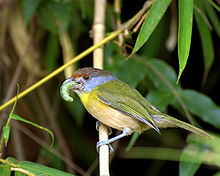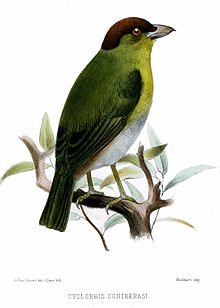- Rufous-browed Peppershrike
-
Rufous-browed Peppershrike 
C. g. ochrocephala feeding on a larva in São Paulo, Brazil Conservation status Scientific classification Kingdom: Animalia Phylum: Chordata Class: Aves Order: Passeriformes Family: Vireonidae Genus: Cyclarhis Species: C. gujanensis Binomial name Cyclarhis gujanensis
(Gmelin, 1789)The Rufous-browed Peppershrike, Cyclarhis gujanensis, is a passerine bird in the vireo family. It is widespread and often common in woodland, forest edge, and cultivation with some tall trees from Mexico and Trinidad south to Argentina and Uruguay.
The adult Rufous-browed Peppershrike is approximately 15 cm long and weighs 28 g. It is bull-headed with a thick, somewhat shrike-like bill, which typically is blackish below and pinkish-grey above. The head is grey with a strong rufous eyebrow. The upperparts are green, and the yellow throat and breast shade into a white belly. The subspecies ochrocephala from the south-eastern part of its range has a shorter rufous eyebrow and a brown-tinged crown, while the subspecies virenticeps, contrerasi and saturata from north-western Peru and western Ecuador have greenish-yellow (not grey, as in the "typical" subspecies) nape, auriculars and cheeks.
The song is a whistled phrase with the rhythm Do you wash every week?, but there are extensive variations depending on both individual and range. It is often heard but hard to see as it feeds on insects and spiders high in the foliage, though it has been observed to take small lizards as well.[1]
The nest is a flimsy cup high in a tree with a typical clutch of two or three pinkish-white eggs lightly blotched with brown.
References
- ^ Carlos A. Delgado-V. & Daniel M. Brooks (2003). "Unusual vertebrate prey taken by Neotropical birds". Ornitología Colombiana 1: 63–65. http://www.ornitologiacolombiana.org/REVISTA/Delgado.pdf.
- BirdLife International (2004). Cyclarhis gujanensis. 2006. IUCN Red List of Threatened Species. IUCN 2006. www.iucnredlist.org. Retrieved on 10 May 2006. Database entry includes justification for why this species is of least concern
- ffrench, Richard (1991). A Guide to the Birds of Trinidad and Tobago (2nd edition ed.). Comstock Publishing. ISBN 0-8014-9792-2.
- Hilty, Steven L (2003). Birds of Venezuela. London: Christopher Helm. ISBN 0-7136-6418-5.
Categories:- IUCN Red List least concern species
- Cyclarhis
- Birds of El Salvador
Wikimedia Foundation. 2010.


